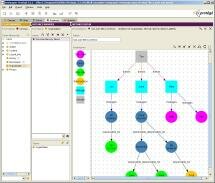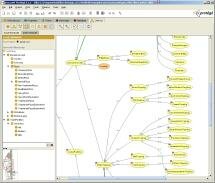Protégé – Open Source Ontology Editor and Knowledge Acquisition System
By admin on Oct 20, 2007 in Java, open source, semantic web
Protégé is a free, open source ontology editor and knowledge-base framework. I used it together with GATE, Crunch , Lucene,and other tools to create my knowedge-based system with automated ontology population.
As quoted from the website, Protégé is a free, open-source platform that provides a growing user community with a suite of tools to construct domain models and knowledge-based applications with ontologies. At its core, Protégé implements a rich set of knowledge-modeling structures and actions that support the creation, visualization, and manipulation of ontologies in various representation formats. Protégé can be customized to provide domain-friendly support for creating knowledge models and entering data. Further, Protégé can be extended by way of a plug-in architecture and a Java-based Application Programming Interface (API) for building knowledge-based tools and applications.
An ontology describes the concepts and relationships that are important in a particular domain, providing a vocabulary for that domain as well as a computerized specification of the meaning of terms used in the vocabulary. Ontologies range from taxonomies and classifications, database schemas, to fully axiomatized theories. In recent years, ontologies have been adopted in many business and scientific communities as a way to share, reuse and process domain knowledge. Ontologies are now central to many applications such as scientific knowledge portals, information management and integration systems, electronic commerce, and semantic web services.
The Protégé platform supports two main ways of modeling ontologies:
- The Protégé-Frames editor enables users to build and populate ontologies that are frame-based, in accordance with the Open Knowledge Base Connectivity protocol (OKBC). In this model, an ontology consists of a set of classes organized in a subsumption hierarchy to represent a domain’s salient concepts, a set of slots associated to classes to describe their properties and relationships, and a set of instances of those classes – individual exemplars of the concepts that hold specific values for their properties.

- The Protégé-OWL editor enables users to build ontologies for the Semantic Web, in particular in the W3C’s Web Ontology Language (OWL). “An OWL ontology may include descriptions of classes, properties and their instances. Given such an ontology, the OWL formal semantics specifies how to derive its logical consequences, i.e. facts not literally present in the ontology, but entailed by the semantics. These entailments may be based on a single document or multiple distributed documents that have been combined using defined OWL mechanisms” (see the OWL Web Ontology Language Guide).

It is a must-have if you are working on semantic web and ontology related knowledge system.

sandeep | Mar 25, 2008 | Reply
i looked your site during my protege editor research. this is really nice .
can i asked you one question that what are future of protege in research .
Nadia Imdadi | Mar 11, 2010 | Reply
Hi,
You mentioned about using several tools along with protege, I will like to know whether you integrated these with the protege. Is the application for ontology population available, if so where can I find it.
Regards,
Nadia